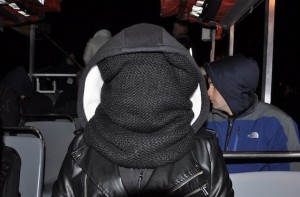
(Alexandra Schwappach/Medill News Service) Ja'Nel Johnson, Immigration and Demographics reporter for the Medill News Service, is literally bundled head-to-toe for the 36th Annual Marine Corps Marathon. When the press bus left for the start line, it was a frigid 34 degrees in Washington.
WASHINGTON — I recently spent a freezing Sunday morning on a boat-shaped, open-air press bus — Duck Boat usually used to ferry tourists around D.C. — to cover the 36th Annual Marine Corps Marathon. Having never covered a marathon before, I feared the hustle and bustle would cause me to miss something. In crowds of 30,000 or more, it’s easy to become overwhelmed. Should you ever cover a marathon, here are several tips to keep in mind:
• Bring lots of layers of clothing: The MCM is usually in October so it can get pretty chilly. When I was there it stayed a glacial 34 degrees pretty much the entire time. But once you’re running around, chasing runners and asking for quotes, you’ll want to start ripping off layers. And don’t forget to wear gloves you can write in and shoes that can withstand a heavy caking of mud.
• Snacks, snacks, snacks: Snacks are useful not only to keep your energy up, but to share with other journalists who, if you’re lucky, will ask for your business card and may help you find a job down the road. At least that’s the hope.
• Reserve a spot on the media van — or not: There are pros and cons to riding with a group of fellow reporters on a boat-bus. Pros: You get to know which runners are leading the race, talk to seasoned journalists and are basically first in line to take a picture of the winner and grab an interview. Cons: You won’t get to see any of the other runners (and there are usually some quirky ones who dress up), you have to get to the race extra early to get a spot on the vehicle (5:30 a.m. on a Sunday?), and you can’t get off to go to the bathroom. Riding on the press vehicle worked for me because I was writing a spot story on the marathon winners, but if you plan on writing a more colorful story about the race, I would suggest having a different plan.
• Push your way to the front: As soon the marathon winner crosses that finish line, you can bet that every journalist present will be up in his face, making it difficult to see or hear him. Don’t be afraid to push your way to the front (especially if you’re a small woman like me). If you don’t, you could miss a colorful quote or not get any interview at all. Bring your recorder to avoid fumbling with a pen and notebook.
• Bring a buddy: If you’re a print reporter, consider asking a video reporter to come along with you to shoot video at the event. It helps to have someone with you and you can cover more ground that way.
• Maybe know how to work the camera before you leave the office: Just an idea.
